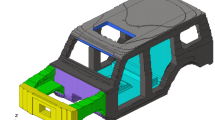Abstract
Body-in-white (BIW) is the Car body with welded sheet metal parts painted in white. Automobile companies were trying to optimize mass and improve performance with optimal mass addition. In many automotive industries many BIW designs due to aggressive mass optimization, there is a need to have smart solutions to improve BIW structure performance with very little mass increase. In this paper, a new technique of identifying the optimized internal reinforcements in the BIW at conceptual BIW design phase using Deign of experiments and Multi-objective optimization has been investigated. The paper focus on the Bending and torsion stiffness load cases to evaluate the BIW performance. Bulk head designs were designed at the major joints like A-pillar, B-pillar, C-pillar and rocker and their optimal locations to improve stiffness with minimum mass increase were identified using Design of experiments and multi objective techniques. The research shows that the optimized Bulk head design locations using the DOE technique has improved the overall BIW stiffness performance by 3.9% with 1.2% of mass addition in the BIW.
Similar content being viewed by others
References
G. Peterson, Cost-effectiveness of a lightweight BIW design for 2020-2025: An assessment of a midsize crossover utility vehicle body structure, SAE International, 2013-01-0667.
J. Conklin, BIW design and CAE, SAE, 2015-01-0408 (2015).
N. Gnanasekar, Finite element simulation of knuckle and strut arm column assembly for automotive steering system, Int. J. Vehicle Structures & Systems, 7 (4) 17–22, doi:10.4273/ijvss.7.4.01.
B. Miao, Evaluation of railway car body fatigue life and durability using multi-disciplinary analysis method, Int. J. Vehicle Structures & Systems, 7 (4) 17–22, doi:10.4273/ijvss. 1.4.05.
B. Matteo and D. Poerre, Topology optimization for minimum weight with compliance and stress constraints, Structural Multi Disciplinary optimization, Springer, DOI 10.1007/s00158-012-0759-7.
G. Zhou et al., The lightweight of auto body based on topology optimization and sensitivity analysis, SAE Technical Paper, 2015-01-1367 (2015) doi:10.4271/2015-01-1367.
D. Baskin, A case study in structural optimization of an automotive body-in-white design, SAE Technical Paper, 2008-01-0880.
J. Christensen, Lightweight hybrid electrical vehicle structural topology optimisation investigation focusing on crashworthiness, Int. J. Vehicle Structures & Systems, 3 (2) 113–1.
Y. W. Lee, A Study on the improvement of the structural joint stiffness for Aluminum BIW, SAE Technical Paper, 970583 (1997).
Y. Y. Yim, Developement of optimal design program for vehicle side body considering the BIW stiffness and light weight, SAE Technical Paper, 2007-01-2357 (2007).
A. V. Londhe, A systematic approach for weight reduction of BIW panels through optimization, SAE Technical Paper, 2010-01-0389 (2010).
D.-K. Leu and Z.-W. Zhuang, Springback prediction of the vee bending process for high-strength steel sheets, Journal of Mechanical Science and Technology, 30 (3) (2016) 1077–1084.
J. Rao, Three-dimensional shape optimization through design of experiments and meta models in crash analysis of automobiles, SAE Technical Paper, 2013-26-0032.
M. Khani, Design of lightweight magnesium car body structure under crash and vibration constraints, Journal of Magnesium and Alloys, Elsevier (2014) 99–108.
R. G. Boeman, Development of a cost competitive, composite intensive, body-in-white, SAE Technical Paper, 2001-01-1905 (2002).
J.-S. Park, Optimal Latin-hypercube designs for experiments, Journal of Statistical Planning and Inference, Elsevier, 39 (1) (1994) 95–111.
Q. Lyu, Z. Xiao, Q. Zeng, L. Xiao and X. Long, Implementation of design of experiment for structural optimization of annular jet pumps, Journal of Mechanical Science and Technology, 30 (2) (2016) 585–592.
M. Rajasekaran, V. Hari Ram and M. Subramanian, Multiobjective optimization of material layout for body-in-white using design of experiments, Int. J. Vehicle Structures & Systems, 8 (1) (2016) 17–22, doi:10.4273/ijvss.8.1.04.
B. Liu, A research on the body-inwhite (BIW) weight reduction at the conceptual design phase, SAE Technical Paper, 2014-01-0743.
P. Calvo, Design optimization of hybrid body-in-white, SAE Technical Paper, 2013-01-0970.
Q. Zhang, A simulation analysis and optimization of mode and stiffness of BIW, SAE-China, Proceedings of the FISITA2012 World Automotive Congress, Springer-Verlag berlin Heidelberg (2013).
J. Deleener, Extraction of static car body stiffness from dynamic measurements, SAE International, 2010-01-0228.
M. Rajasekaran, A new minimal part breakup body-inwhite design approach and optimized material map strength assessment, Journal Teknologi, 78 (7) (2016) 17–22.
Author information
Authors and Affiliations
Corresponding author
Additional information
Recommended by Editor Yeon June Kang
Rajasekaran Mohan is a Ph.D. scholar in Hindustan Institute of Technology and Science, received M.E. (Computer Aided Design) from Anna University, Chennai, and Graduated B.E. (Mechanical) from University of Madras, Chennai. He has 12 years of experience in the CAE, Vehicle Body Simulations and Optimizations for Crash and NVH. He has expertise in the Car Body load path design, study and performance optimizations.
Hariram Venkatesan is an Associate Professor in Automobile Engineering Department at Hindustan Institute of Technology and Science, received Ph.D. from Anna University, Chennai, M.E. (Automobile Engineering) from Anna University and Graduated BE (Mechanical) from University. He has 10 years of experience in the Biofuel, Automotive engines, Alternate fuels, Bio-Mechanics, Simulation, Re-engineering, Combustion and Automotive Instrumentation and Vehicle Body Design/Engineering. He has nearly 39 Publications in SCOUPUS indexed Journals. He is currently guiding more than 4 Ph.D. scholars in the field of Automotive and Mechanical Engineering.
Rights and permissions
About this article
Cite this article
Mohan, R., Venkatesan, H. & Mahadevan, S. New methodology for light weight solutions to improve BIW structural performance using bulk head optimization. J Mech Sci Technol 30, 3533–3537 (2016). https://doi.org/10.1007/s12206-016-0713-5
Received:
Revised:
Accepted:
Published:
Issue Date:
DOI: https://doi.org/10.1007/s12206-016-0713-5




